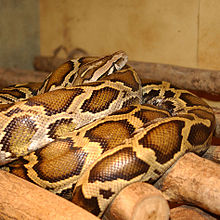| Henophidia | |
|---|---|

| |
| Burmese python, Python bivittatus | |
| Scientific classification | |
| Domain: | Eukaryota |
| Kingdom: | Animalia |
| Phylum: | Chordata |
| Class: | Reptilia |
| Order: | Squamata |
| Suborder: | Serpentes |
| Clade: | Afrophidia |
| Superfamily: | Henophidia |
Henophidia is a former superfamily of the suborder Serpentes (snakes) that contains boas, pythons and numerous other less-well-known snakes.
Snakes once considered to belong to superfamily Henophidia include two families now considered Amerophidia (Aniliidae – red pipe snakes, and Tropidophiidae – dwarf "boas" or thunder snakes), three families now considered Uropeltoidea (Cylindrophiidae – Asian pipe snakes, Anomochilidae – dwarf pipe snakes, and Uropeltidae – shield-tailed snakes and short-tailed snakes), three families now considered Pythonoidea (Pythonidae – pythons, Loxocemidae – Mexican burrowing snake, and Xenopeltidae – sunbeam snakes), at least one family now considered Booidea (Boidae – boas ), and Bolyeriidae – Round Island splitjaw snakes.
Because these snakes do not form a monophyletic group they can no longer be formally referred to using a single name. In modern usage, "Henophidia" is often placed in quotes, because it can be convenient to refer to all lineages that used to be considered Henophidia. Another way of thinking about it is that "henophidian" snakes are all snakes that are not Scolecophidia (blindsnakes) or Caenophidia (so-called "advanced snakes"). "Henophidian" snakes are sometimes said to be more "basal" or "primitive" than those belonging to the Caenophidia, but this does not mean that they are inferior or that they have evolved less, rather that we think they share more traits with their common ancestor in comparison to the Caenophidia.
Etymology
Henophidia comes from the Greek heno- meaning one or former and ophidia meaning serpent, so former/older snakes (in contrast to Caenophidia, i.e. recent snakes).
Former families
- Aniliidae – coral pipe snakes and pipe snakes.
- Anomochilidae – dwarf pipe snakes.
- Boidae – boas (including sand boas)
- Bolyeriidae – Round Island boas.
- Cylindrophiidae – Asian pipe snakes.
- Loxocemidae – Mexican burrowing snake.
- Pythonidae – pythons
- Tropidophiidae – dwarf boas.
- Uropeltidae – shield-tailed snakes and short-tail snakes.
- Xenopeltidae – sunbeam snakes.
References
- ^ Reynolds, RG; Niemiller, ML; Revell, LJ (2014). "Toward a Tree-of-Life for the boas and pythons: multilocus species-level phylogeny with unprecedented taxon sampling" (PDF). Molecular Phylogenetics and Evolution. 71: 201–213. doi:10.1016/j.ympev.2013.11.011. PMID 24315866. Archived from the original (PDF) on 2015-12-02. Retrieved 2018-05-14.
- ^ Scanlon, J. D.; Lee, M. S. Y. (2011). Aldridge, R. D.; Sever, D. M. (eds.). The Major Clades of Living Snakes: Morphological Evolution, Molecular Phylogeny, and Divergence Dates in Reproductive Biology and Phylogeny of Snakes. Enfield, NH: Science Publishers. pp. 55–95.
- Vitt, L. J.; Caldwell, J. P. (2014). Herpetology: an introductory biology of amphibians and reptiles (4th ed.). Burlington: Academic Press. pp. 108–109.
- Streicher, J. W.; Ruane, S. (2018). "Phylogenomics of Snakes". eLS: 1–8. doi:10.1002/9780470015902.a0027476. ISBN 9780470015902.
- heno- at wordinfo.info
- -ophidia at wordinfo.info
| Taxon identifiers | |
|---|---|
| Henophidia | |
This snake article is a stub. You can help Misplaced Pages by expanding it. |